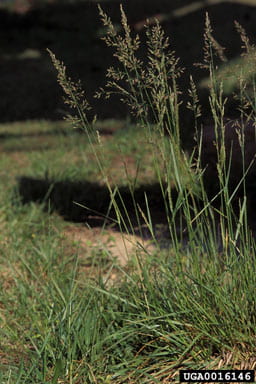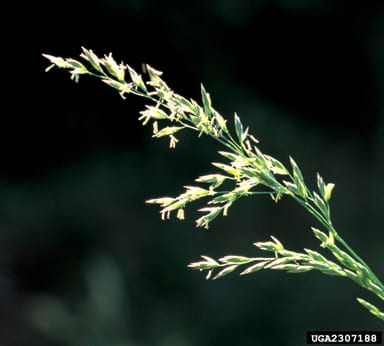Scientific names: Schedonorus arundinaceus, previously Festuca arundinacea
Other names: tall rye grass, alata fescue, reed fescue, coarse fescue
Tall fescue is a cool season perennial that vigorously produces seed and can easily take over an area due to the allelopathic compounds it produces. It originated in Europe and central Asia, and is widespread throughout the U.S. and southern Canada. Tall fescue may be a problem in many environments, including natural areas as well as agriculture, and is especially problematic in small fruit crop systems in NYS. It has a fibrous root system and grows in various soil conditions, but is most competitive in clay soils with high organic matter.
Dangers to livestock
A fungus, Acremonium coenophialum, can infect tall fescue. If ingested by horses, this can lead to fescue toxicosis. For more information, look at Cornell’s Plants Poisonous to Livestock webpage: https://poisonousplants.ansci.cornell.edu/toxicagents/fesalk.html
Identification
Leaves: The ligule is membranous. There are no hairs on the blade.
Leaf blade length: 4-5 in (10-12.7 cm)
Leaves and collar region of tall fescue.
Photo by Randy Prostak of UMass Extension Landscape, Nursery and Urban Forestry Program
Mature plant: The root system is fibrous.
Height: 0.5-6 ft (0.15-1.8 m)
Leaf blade size: 0.4 in (1 cm) wide by 3-28 in (10-70 cm) long
Flower head of tall fescue.
Photo by James H. Miller and Ted Bodner of Southern Weed Science Society, via Bugwood.org
Seed head of tall fescue.
Photo by Randy Prostak of UMass Extension Landscape, Nursery and Urban Forestry Program
Management
Chemical
Commodity specific guidance for weed management can be found in the Cornell Crop and Pest Management Guidelines.
Cornell’s Turfgrass and Landscape Weed ID website also has more weed identification and management information.
Non-chemical
Where tall fescue is less of a problem, consider a controlled burn to kill seedlings. Seed set should be prevented to control further spread.
Climate Change and Management
Tall Fescue (Schedonorus arundinaceus) is known for its competitiveness with crops and its harmful effects on grazing animals due to an endophytic fungus. Although increased CO2 has not been shown to affect its competitiveness, climate change may expand its range and increase its threat as a weed.
# of studies referenced in this section: 2
Similar species
Table 13: Shows tall fescue (Schedonorus arundinaceus) similarities and differences in identification compared to its similar species: quackgrass (Elytrigia repens) and ryegrasses (Lolium multiflorum and Lolium perenne).
| Species | Tall fescue (Schedonorus arundinaceus) | Quackgrass (Elytrigia repens) | Ryegrasses (Lolium multiflorum, L. perenne, etc.) | ||
|---|---|---|---|---|---|
| Similarities | Leaf bud rolled; ligule membranous | Leaf bud rolled; ligule membranous | Leaf bud rolled; ligule membranous | ||
| Differences | Auricles blunt and short, can be absent; lack lengthened rhizomes; grows in a clump; coarse-textured and dark green foliage | Auricles long and clasping (often not present on seedlings); long, pointed rhizomes | Auricles of ryegrass spp. are claw-like |
Herbicide resistance
Reported as of 2021:
None
Visit the International Herbicide-Resistant Weed Database homepage for more information on resistance.
References
UC IPM has a tall fescue profile that discusses identification and its biology.
Cornell University’s Department of Animal Science has a tall fescue discussing fescue toxicosis.
The Missouri Department of Conservation has a page on tall fescue identification and control.
The USDA has a resource addressing invasive grasses and includes a profile on tall fescue.
Fire Effects Information System has a database that discusses biology, general distribution, and management considerations of tall fescue.
For New York State specific distribution and common names for tall fescue see the New York Flora Atlas site.
For Turfgrass information check out this tall fescue profile from Texas Cooperative Extension.










